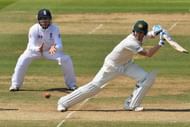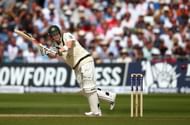Graeme Swann is no Dale Steyn. Graeme Swann cannot break your bones – his gentle off-breaks can cause you no physical injury. However, the effortless ease with which he can bamboozle you and knock those bails off your stumps can inflict deep mental scars, which are sometimes more difficult to heal than a broken bone or two.
In the first Test of the Border-Gavaskar series earlier this year, the Australians lost all twenty wickets to spinners. Ashwin, Harbhajan, and Jadeja managed to weave their web around the Aussies, and barring a certain Michael Clarke, each and every batsman failed spectacularly against any level of slow bowling.
The rest of the series didn’t provide much respite for Clarke’s men. They were whitewashed 4-0, and it would be a massive understatement to say that they were outplayed by the Indian spinners. They were humiliated, disgraced, shamed, and forced into a state of absolute disorientation by the spin quartet of Ashwin, Harbhajan, Jadeja and Ojha. The numbers mirror the story of the series – sixty five of their eighty wickets fell to spin.
Clearly, something is very wrong. Following the high profile retirements of Langer, Martyn, and Hayden within short intervals of each other, the new legion of Aussie batsmen seem to be totally at sea facing any form of spin.
Practice makes a man perfect. And that’s precisely the problem plaguing the Aussies – their batsmen have little, if not any practice playing against top quality spin bowling. Sure, they may have a few local, everyday heroes in Bryce McGain, Jason Krejza, Nathan Hauritz, and Xavier Doherty, but it doesn’t take rocket science to say that none of these bowlers is anywhere near international quality.
The spinners that the Australian batsmen face in their domestic tournaments are just not good enough to give them any sort of exposure to the real world – a world where bowlers like Ashwin and Ajmal can make you look more clueless than a goat at a Star Wars convention.
The short term quick-fix would be to give the batsmen a crash course on how to play against the turning ball. They do not need to look too far for inspiration – their skipper Michael Clarke is undoubtedly one of the best players of spin bowling in the world at the present moment. Watching a twenty minute video of him facing a spinner would teach them more than any coaching manual ever could.
Clarke uses his feet to the fullest, dancing down the wicket at the slightest opportunity – thus employing arguably the best possible way to combat spin. By playing in the gaps and continuously rotating the strike, Clarke ensures that he keeps the scoreboard ticking and does not allow the bowler to settle down – and there is nothing a bowler dislikes more than having to change his plan of action every ball.
Also, he is one of the few batsmen who read the spinner off the hand itself. Waiting for the ball to pitch before setting yourself up would be too late – Chris Rogers learnt that the hard way, Swann cleaning him up in the second innings of the Lord’s Test after he left a ball he presumed would turn the other way.
While these may not be fool proof ways of playing a spinner, and may not guarantee a one hundred percent success rate, they are tried and tested methods that could provide temporary relief, and help the Aussies avoid further massacre at the hands of Swann and co. in England.
The long term vision though, must be to produce a generation of batsmen who feel perfectly at home playing spin – the vision must be to produce batsmen who can face wily spinners with the same confidence with which they face medium pacers. And the best way of ensuring that this vision eventually becomes a reality is to produce more quality spinners of their own. However, these spinners won’t magically appear overnight. They need to be bred; they need to be cultivated; they need to be nurtured.
Stuart MacGill, yet another outstanding leggie unfortunate enough to have been born in Warne’s era of dominance, believes that the entire generation of Australian spinners have been “horribly handled and badly coached”. To bring about a transformation in the management of slow bowlers, he accepted a job as a spin consultant in Cricket Australia’s Centre of Excellence in April this year.
If a man is defined by the company he keeps, there appears to be no near future for spinners in Australian cricket. After all, there are no world-class spinners currently playing Down Under. There is no idol for youngsters to look up to in the Australian spin bowling department – there is no real role model. And therefore, there is not much motivation for any young Australian to become a spinner.
Of course, Shane Warne might be the greatest spin bowler to have ever played the gentleman’s game. But, there’s a world of difference between a retired legend and a current hero. Even just a cursory glance at the half-decent Australian spinners show that they are all in their thirties – Krejza, McGain, and Doherty have all played alongside Warne at some point in their careers – and they surely would have picked up some tricks of the trade from the wizard himself.
Last season South Australia’s domestic team (Southern Redbacks) roped in South African spinning all-rounder Johan Botha to captain their side for the Sheffield Shield. Almost instantaneously, a revolution was brought about.
Sharing the dressing room with a seasoned veteran like Botha rapidly raised the overall standards – Cullen Bailey, Tom Cooper and Adam Zampa were suddenly bowling more of wicket taking deliveries and less of long-hops. Meanwhile, hours of facing Botha in the nets paid rich dividends for the Redbacks batsmen, who got priceless training against first-rate, international quality spin bowling.
Following the immense success of Johan Botha’s inclusion, Cricket Australia must open their doors to a greater number of foreign players in the Sheffield Shield and other domestic tournaments. They must give priority to overseas spinners; they must offer lucrative deals that the foreign players just cannot refuse.
Murali Kartik, Harbhajan Singh, Malinga Bandara, and Monty Panesar are all proven performers who do not get opportunities playing for their own countries – these are the types of players Cricket Australia should try to acquire.
A result of acquiring talent from outside when none is available at home, was visible in Australia fast-tracking the leg-spinner Fawad Ahmed to international team’s door recently.
When Fawad came seeking asylum Down Under in 2010, Australia saw the opportunity and after good results in the domestic circuit, have done the right thing to grant him citizenship. At 31, he still has a lot to offer to Australian cricket.
Cricket Australia need to send their young, emerging players to the subcontinent – to play on pitches that support spin. Batsmen need to get acclimatised to all types of surfaces as early in their careers as possible, and the subcontinent would be the ideal location to learn how to play on rank turners.
Playing on the dustbowls in India and Sri Lanka will give the rookie Australian batsmen invaluable experience – experience that would mould them into becoming better cricketers. Inexperienced, promising spinners need to bowl in conditions which are suited to their needs – it will boost their confidence, and help them to no end when they move on to bigger and greater challenges.
Currently, Adelaide and Sydney are the only two stadiums Down Under that can be leniently labelled as spinner-friendly tracks. CA needs to ensure that more stadiums prepare pitches that encourage spin. Matches need to be played on those spinning surfaces, and batsmen need to be given ample opportunities to bat on those tracks.
Talented cricketers must be given a long rope – bad performances in two or three matches are definitely not an indicator of a player’s potential.
The revival of Australian batting against spin bowling promises to be a challenging journey – it will certainly be no cakewalk. But it is a journey that must be undertaken; a path that must be trodden upon – for, the cricketing world desperately needs Australia to be back at their unshackled, intimidating best.
Brand-new app in a brand-new avatar! Download Cric Rocket for fast cricket scores, rocket flicks, super notifications and much more!


